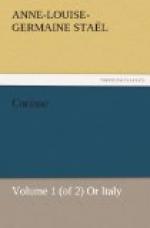When we place ourselves in the midst of the crossroads from which the city that remains standing almost entire is seen on all sides, it seems to us as if we were waiting for somebody, as if the master were coming; and even the appearance of life which this abode offers makes us feel more sadly its eternal silence. It is with petrified lava that the greater part of these houses are built, which are now swallowed up by other lava. Thus ruins are heaped upon ruins, and tombs upon tombs. This history of the world, where the epochs are counted from ruin to ruin, this picture of human life, which is only lighted up by the Volcanoes that have consumed it, fill the heart with a profound melancholy. How long man has existed! How long he has suffered and died! Where can we find his sentiments and his thoughts? Is the air that we breathe in these ruins impregnated with them, or are they for ever deposited in heaven where reigns immortality? Some burnt leaves of manuscripts, which have been found at Herculaneum, and Pompei, and which scholars at Portici are employed to decipher, are all that remain to give us information of those unhappy victims, whom the Volcano, that thunder-bolt of earth, has destroyed. But in passing near those ashes, which art has succeeded in reanimating, we are afraid to breathe lest a breath should carry away that dust where noble ideas are perhaps still imprinted.
The public edifices in the city itself of Pompei, which was one of the least important of Italy, are yet tolerably fine. The luxury of the ancients had almost ever some object of public interest for its aim. Their private houses are very small, and we do not see in them any studied magnificence, though we may remark a lively taste for the fine arts in their possessors. Almost the whole interior is adorned with the most agreeable paintings and mosaic pavements ingeniously worked. On many of these pavements is written the word Salve. This word is placed on the threshold of the door, and must




